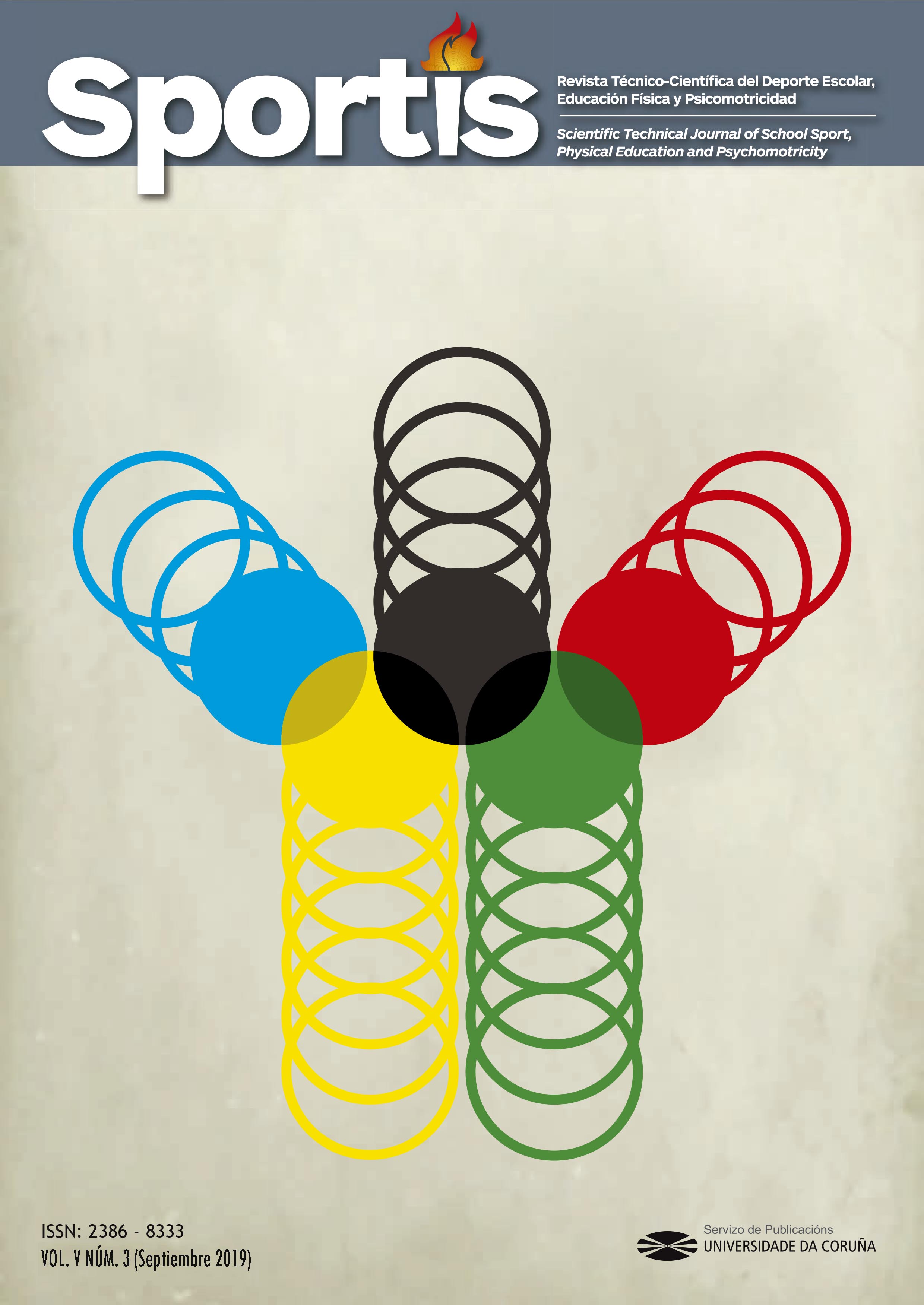Traditional archery: A pilot study of surface electromyography
Main Article Content
Abstract
Archery has always been a minority sport, therefore is a little investigated sport. The aim was to determinate the importance of brachial biceps of the draw arm, lateral portion of the brachial triceps of the drow arm, anterior abdominal and lumbar portion of erector spinae during the technic action of archery in the divisions of longbow and instictive bow. Brachial biceps of the draw arm, lateral portion of the brachial triceps of the drow arm, anterior abdominal and lumbar portion of erector spinae of six archers were analised by surface electromyography. The results of the study reflects a similar pattern of maxim activation is appreciated as on the absolute activation in four of the six archers with higher level of experience and performance and better adaptability to the personal training bow. Both the archers with different pattern of maxim and absolute activation, have similar patterns between them. Being the results of the study non suitables to the generalization, a higher implication of lateral portion of the brachial triceps of the drow arm is more necessary than the brachial biceps of the draw arm. In spite of the fact that it is not possible to compare the implication of the anterior abdominal with the activation of the lumbar portion of erector spinae, the maxim and absolute implication of the erector spinae may have influence in a inestable body posture during the archery technic. More investigation is needed to go deeper in these contents.
Keywords:
Downloads
Article Details
References
BiosignalsPlux. (2017). BiosignalsPlux: wireless biosignals. Lisboa,Portugal: Learn/Publications. Recuperado de: http://biosignalsplux.com/en
BiosignalsPlux. (2017). Electromyography (EMG) Sensor Data Sheet [En línea]. [Consultada el 09/06/2018] Recuperado de: http://biosignalsplux.com/datasheets/EMG_Sensor_Datasheet.pdf
Busquet L. (2002). Las cadenas musculas. Tomo I. Tronco, columna cervical y miembros superiores. Barcelona, España: Paidotribo.
Busquet L. (2001). Las cadenas musculas. Tomo IV. Miembros inferiores. Barcelona, España: Paidotribo.
Cabrera Ávila E. V., Montes Fernández E. I. (2012). Obtención y análisis de señales electromiográficas de las articulaciones tibiofemoral y femororotuliana aplicada a la detección y rehabilitación de problemas musculares en el movimiento de la rodilla (tesis de Ingeniería). Universidad Politécnica Salesiana, Cuenca, Ecuador. Recuperado de: https://dspace.ups.edu.ec/bitstream/123456789/2819/1/UPS-CT002464.pdf
Consejo Superior de Deportes (2018) Memoria 2016/ Licencias y Clubes federados. [En línea]. [Consultada el 10/11/2017]. Versión PDF. Recuperado de: http://www.csd.gob.es/csd/estaticos/asoc-fed/historico-de-licencias.pdf
Enoka R.M. (2015) Neuromechanics of Human Movement. 5ed. Champaign: Human Kinetics.
Ertan, H. (2009). Muscular activation patterns of the bow arm in recurve archery, Journal of Science and Medicine in Sport, 12(3), 357-360. DOI: https://doi.org/10.1016/j.jsams.2008.01.003
Ertan, H., Soylu, A. R., & Korkusuz, F. (2005). Quantification the relationship between FITA scores and EMG skill indexes in archery. Journal of Electromyography and Kinesiology, 15(2), 222-227. https://doi.org/10.1016/j.jelekin.2004.08.004
Gianikellis, K. Maynar Marino, M. Arribas Fernández, & F (1997). La electromiografía (emg) como método para determinar la intervención muscular en los deportes de precisión. Consejo Superior de Deportes. Serie ICd 13.
Jiménez, E. (1988). Tiro con Arco. Técnica, Mecánica y Planificación del Entrenamiento. Madrid, España: ESM.
Krašna, S., Đorđević, S., Hribernik, M., & Trajkovski, A. (2017). A novel approach to measuring muscle mechanics in vehicle collision conditions. Sensors (Basel, Switzerland), 17(6), 1389. https://doi.org/10.3390/s17061389.
Lee k, Benner T. (2009). Shoulder Alignament. En: Adamson Spencer, (Ed), Total archery inside thearcher. 1 ed. (pp. 190-196). California U.S.A.: Astra LLC
Lluch, A., Salvà, G., Esplugas, M., Llusá, M., Hagert, E., & Garcia-Elias, M. (2015). El papel de la propiocepción y el control neuromuscular en las inestabilidades del carpo. Revista Iberoamericana de Cirugía de la Mano, 43(1), 70-78. https://doi.org/10.1016/j.ricma.2015.06.012 Recuperado de: https://www.sciencedirect.com/science/article/pii/S1698839615000134
Muñoz, J., Gouveia, E., Cameirão, M., & Badia, S. (2017). PhysioLab - a multivariate physiological computing toolbox for ECG, EMG and EDA signals: A case of study of cardiorespiratory fitness assessment in the elderly population. Multimedia Tools and Applications, 77(9), 11521-11546. https://doi.org/10.1007/s11042-017-5069-z.
Myers T.W. (2014) Anatomy Trains – Myofascial Meridians for Manual and Movement Therapists. Munich: Elsevier.
Niestroj C. K, Schöffl V, Küpper T. (2018). Acute and overuse injuries in elite archers. The Journal of Sports Medicine and Physical Fitness. 58 (7-8) 1063-70 https://doi.org/10.23736/S0022-4707.17.07828-8.
Romero-Moraleda, B., La Touche, R., Lerma-Lara, S., Ferrer-Peña, R., Paredes, V., Peinado, A. B., & Muñoz-García, D. (2017). Neurodynamic mobilization and foam rolling improved delayed-onset muscle soreness in a healthy adult population: A randomized controlled clinical trial. PeerJ, 5, e3908. https://doi.org/10.7717/peerj.3908.
Shinohara, H., & Urabe, Y. (2017). Analysis of muscular activity in archery: A comparison of skill level. The Journal of Sports Medicine and Physical Fitness, 58 (12) https://doi.org/10.23736/S0022-4707.17.07826-4
Tejo N., Carvalheiro F., de Sousa E., Toribio T., Fernandes U., Saldanha M., Magalhães F. H., Mochizuki L. (2017). Coordenação no tiro com arco: diferenças entre o iniciante e o atleta de nível internacional. Arquivos de Ciências do Esporte, 5 (1), 13-15. Recuperado de: http://seer.uftm.edu.br/revistaeletronica/index.php/aces/article/view/2084/2116
Vidarte Claros, J.A., Marín Villada, A. F., & Restrepo de Mejía, F. (2013). Comportamiento de la actividad en los músculos primarios del disparo, en deportistas de selección Colombia de arco recurvo. Recuperado de: https://journalusco.edu.co/index.php/entornos/article/view/495
Villarroya Aparicio, M. A. (2005). Electromiografía cinesiológica. Rehabilitación, 39(6), 255-264. DOI: https://doi.org/10.1016/s0048-7120(05)74359-0. Recuperado de: https://www.sciencedirect.com/science/article/pii/S0048712005743590






